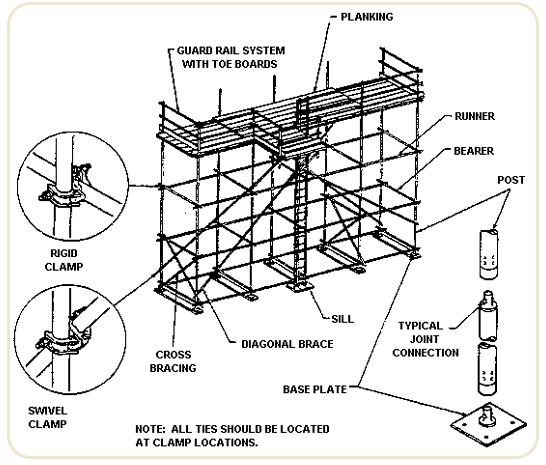Quality Scaffolding Surrey for Both Residential and Commercial Projects
Quality Scaffolding Surrey for Both Residential and Commercial Projects
Blog Article
A Comprehensive Guide to the Necessary Attributes of Scaffolding in Modern Building And Construction
The landscape of modern construction increasingly depends on reliable scaffolding systems that prioritize safety, efficiency, and innovation. As projects expand in complexity, understanding the important features of scaffolding becomes vital for ensuring employee safety and maximizing job timelines. This guide discovers numerous kinds of scaffolding, highlights vital safety and security features, and analyzes material improvements that contribute to efficiency and sustainability. Nonetheless, the implications of these aspects prolong much past plain construction practices, prompting a closer look at exactly how they influence total task success and employee wellness.
Types of Scaffolding
Although scaffolding systems can vary commonly in design and application, they usually fall into numerous distinct categories that cater to various building demands - Scaffolding. One of the most usual types include supported scaffolding, suspended scaffolding, and rolling scaffolding
Supported scaffolding includes platforms sustained by a framework of posts, which provide a raised and steady functioning surface. This kind is usually used for tasks that need significant elevation, such as bricklaying or external painting.
Suspended scaffolding, conversely, is used for projects calling for accessibility to high altitudes, such as cleansing or fixing building exteriors. This system hangs from a rooftop or another structure, allowing workers to reduced or increase the platform as required.
Rolling scaffolding features wheels that enable for very easy mobility throughout a work site. It is specifically helpful for tasks that call for constant relocation, such as indoor operate in huge rooms.
Each sort of scaffolding is designed with certain applications in mind, making certain that construction tasks can be performed successfully and properly. Comprehending these classifications is essential for selecting the suitable scaffolding system to satisfy both job needs and website conditions.
Secret Safety Functions
Safety and security is critical in scaffolding systems, as the potential risks associated with functioning at heights can result in significant mishaps if not appropriately handled. Secret safety and security features are necessary to make sure the health of employees and the integrity of the building site.
Primarily, guardrails are essential. These obstacles supply a physical protect versus drops, dramatically minimizing the risk of severe injuries. Additionally, toe boards are commonly utilized to stop tools and materials from diminishing the scaffold, shielding employees listed below.
Another crucial component is using non-slip surface areas on systems. This feature enhances hold, particularly in unfavorable weather condition problems, thereby minimizing the chance of drops and slides. Additionally, accessibility ladders ought to be safely positioned to facilitate safe access and departure from the scaffold.
Normal assessments and upkeep of scaffolding systems are also crucial. These inspections guarantee that all components are in good problem and operating appropriately, dealing with any wear or damage without delay.
Lastly, appropriate training for all employees entailed in scaffolding procedures is necessary to make sure that they recognize safety methods and can recognize potential hazards. Scaffolding. Collectively, these features develop a safer working setting and considerably mitigate dangers related to scaffolding
Product Innovations
Developments in product science have substantially affected the scaffolding market, boosting both security and performance in modern construction. The introduction of high-strength steel and light weight aluminum alloys has reinvented typical scaffolding systems. These products are not only lighter, making them less complicated to put together and carry, however also provide remarkable load-bearing capacities. This results in scaffolding structures that can support greater weights while lessening the threat of collapse.
Additionally, cutting-edge composite materials, such as fiberglass-reinforced plastics, have actually become viable alternatives. These materials are immune to corrosion and ecological deterioration, therefore extending the lifespan of scaffolding systems, specifically in severe weather. Using such materials adds to lower upkeep prices and guarantees regular performance in time.


Style Factors To Consider
Considering the intricacies of contemporary building projects, efficient scaffolding layout is extremely important to making certain both functionality and security. Design considerations have to incorporate different elements, including lots capacity, elevation, and the particular requirements of the building site. Each project provides distinct challenges, requiring a flexible approach to scaffolding systems that can adjust to differing problems.
Architectural honesty is important; therefore, designers have to compute the loads that the scaffolding will sustain, consisting of employees, materials, and equipment. The choice of products plays a critical role in making sure the scaffolding can withstand these loads while remaining light-weight and sturdy. Furthermore, the layout needs to enable for very easy accessibility and egress, promoting the smooth motion of products and employees.
Security functions, such as guardrails and non-slip surface areas, should be incorporated to lessen risks of accidents. The layout has to think about the surrounding atmosphere, including potential risks and adjacent frameworks. By attending to these layout considerations, building firms can boost the effectiveness of scaffolding systems and advertise a much safer working setting, eventually adding to the general success of the job.
Maintenance and Assessments
The efficiency of scaffolding systems expands beyond initial design and execution; continuous maintenance and regular assessments are crucial to ensuring their proceeded performance and safety throughout the period of a job. Routine inspections should be conducted by certified personnel to identify any type of indications of wear, damage, or instability that can jeopardize the stability of the scaffolding.
Maintenance protocols ought to include regular checks of structural components, such as planks, structures, and installations, making certain that all aspects stay complimentary and secure from deterioration or various other damage. Additionally, the performance of safety features, such as guardrails and toe boards, have to be analyzed to ensure conformity with safety and security regulations.
Documents of all assessments and upkeep activities is crucial for accountability and regulatory conformity. A scaffolders yard systematic approach to record-keeping not only aids in tracking the condition of the scaffolding but likewise offers needed evidence in the event of an occurrence.
Eventually, establishing a detailed upkeep and assessment timetable will substantially minimize the danger of crashes and improve the total safety of the building website. By focusing on these techniques, building and construction supervisors can protect employees and support the task's integrity.

Conclusion
To conclude, the essential features of scaffolding in modern building and construction incorporate a series of vital aspects, consisting of varied kinds, vital safety systems, material why not try this out advancements, and thoughtful layout considerations. Highlighting security via guardrails and non-slip surfaces, alongside improvements in materials like high-strength steel, enhances both performance and sustainability. Additionally, normal upkeep and assessments are essential for ensuring structural honesty and safety and security on building and construction websites, ultimately facilitating effective project implementation and advertising the wellness of workers.
The landscape of contemporary building and construction progressively counts on reliable scaffolding systems that prioritize efficiency, safety, and technology.Developments in product scientific research have significantly affected the scaffolding industry, improving both safety and effectiveness in modern-day building and construction. Overall, these product advancements not just boost the performance and safety of scaffolding systems however likewise line up with the market's push in the direction of sustainability, as numerous modern-day products are made to be more ecologically pleasant.
Thinking about the intricacies of modern building tasks, efficient scaffolding layout see this here is paramount to ensuring both capability and safety.In verdict, the necessary features of scaffolding in modern building encompass a variety of crucial components, including varied kinds, vital safety and security devices, material advancements, and thoughtful layout considerations.
Report this page